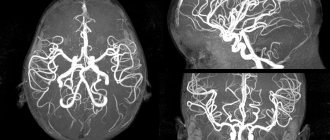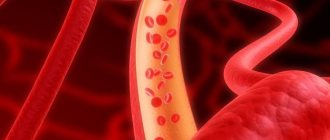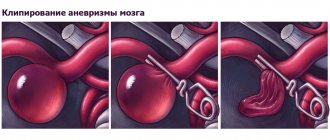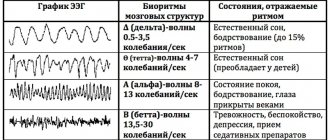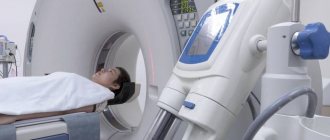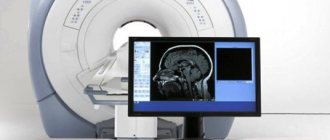Doctors
Prices for services
| Name of service | Price |
| A04.23.001. Transcranial ultrasound examination of the brain | 2800 rub. |
Dear patients! You can find a complete list and cost of services at the reception or by calling 8,.
One of the research methods using ultrasound is the method of transcranial scanning of cerebral vessels, or as it is also called - transcranial Dopplerography. This diagnostic technique is used to study the speed of blood flow, determine hemodynamic changes in flow in the lumens of intracranial vessels, and diagnose their damage. With its help, changes in the circulatory system of the head and neck are detected.
Advantages
The method has its advantages. Thanks to him, you can:
- Identify and evaluate the significance of arterial anomalies in the neck and brain;
- Detect foci of organic vascular damage in the initial stage of their development;
- Monitor the dynamics of venous blood flow and the reserve capabilities of the entire vascular system in a given area;
- Monitor and control the condition of the vertebral arteries;
- Diagnose the causes of various headaches caused by disturbances in the functioning of cerebral vessels
multidisciplinary medical center
The most common manifestations of vascular pathology are headache and changes in mental activity, which is relevant for children and adults.
At the multidisciplinary medical Center for Modern Pediatrics in Voronezh, to assess the state of blood circulation in the vessels of the brain, ultrasound diagnostic doctors perform transcranial Dopplerography (TCDG), a non-invasive method for studying the blood vessels of the human brain. This research method is called “Dopplerography” after the physicist Doppler; the physical laws he discovered are used all over the world to assess the speed of blood flow through the vessels of the brain.
This diagnostic TCD study is highly informative and at the same time safe, since it does not produce radiation exposure to the body of the person being studied, so it can be performed even on very young children, pregnant women, people with chronic diseases and, of course, all adult patients. The limitations for this study are only acute attacks of cardiac and respiratory failure in a child or adult.
Indications for transcranial Doppler sonography in adults and children:
- suspicion of pathological changes in the blood vessels of the head
- encephalopathy
- vascular malformation
- arterial hypertension
TCD is performed if the above pathology is suspected, as well as if it is present for dynamic monitoring of therapy.
Dopplerography of cerebral vessels does not require special preparation , with the exception of taking vascular medications near the examination procedure, as well as smoking and drinking alcohol.
During transcranial Doppler ultrasound, the patient can either sit or lie down. During the TCD procedure, you cannot talk or turn your head. The TCD study itself does not cause discomfort in the patient.
Ultrasound diagnostic doctors at the Center for Modern Pediatrics install an ultrasound sensor above the patient’s auricle, in the projection of the main vessels of the brain. Blood flow through the vessels of all areas of the brain is assessed one by one. Then the sensor is moved to the occipital region to assess the condition of the cerebellar area. In addition, the condition of the intracranial vertebral arteries is assessed.
In children, Doppler sonography of the arteries and veins of the head makes it possible to determine possible developmental and nutritional disorders of brain structures.
Ultrasound diagnostics doctor Galina Viktorovna Vostrikova
Ultrasound diagnostics doctor Alekseenko Tatyana Aleksandrovna
Passing diagnostics
The standard ultrasound procedure in Moscow does not require special preparation, except for giving up alcohol, smoking and taking vascular medications immediately before the procedure. The whole process lasts about half an hour and does not cause any discomfort to the subject.
The procedure begins by applying ultrasound emission gel to the area to be examined. The gel is designed to improve contact of the body surface with the sensor. After this, the specialist touches the treated areas of the neck and head with a sensor.
Transcranial Doppler ultrasound (TCDG)
Transcranial Doppler ultrasound (TCD) is a non-invasive method of ultrasound examination of cerebral blood flow.
The brain has a developed blood flow system that supplies the brain with nutrients, oxygen and removes carbon dioxide, metabolic products. Disturbances in cerebral blood flow may be associated with narrowing of the lumen of the artery (stenosis), blood clot formation (thrombosis), emboli from other sources, or rupture of the vascular wall (hemorrhage). A lack of blood flow to the brain tissue can cause a stroke.
Blood flow through the mogg arteries can be assessed using transcranial Doppler ultrasound sonography. Doppler ultrasound sonography uses the so-called Doppler effect to measure the speed and direction of blood movement in blood vessels. The Doppler effect consists of changing the frequency of a signal reflected from a moving object by an amount proportional to the speed of movement.
TCD makes it possible to detect a decrease in cerebral blood flow velocity, the development of vasospasm of the cerebral arteries, and conduct dynamic monitoring of cerebral blood flow parameters at the patient’s bedside.
During the examination, the patient lies on the bed, a special gel is applied to the skin, and the ultrasound sensor is placed in the acoustic window area (areas of the skull that allow ultrasound examination). There are temporal, suboccipital, and orbital acoustic windows. The study takes on average about 15-30 minutes.
Transcranial Dopplerography allows you to determine:
- Decreased cerebral blood flow rate
- Blood flow asymmetry
- Presence of stenosis of intracranial arteries
- Assess vascular resistance, presence of vasospasm
- Conduct dynamic observation of cerebral blood flow directly at the patient's bedside.
- Efficacy of thrombolytic therapy
- Response to treatment
- Indirectly assess the level of intracranial pressure taking into account hemodynamic parameters
Indications for the study:
- Ischemic stroke
- Carrying out systemic thrombolysis for ischemic stroke (assessment of arterial recanalization)
- Hemorrhagic stroke
- Vasospasm
- Transient ischemic attack
- Chronic cerebral ischemia
- Preparation for carotid edarterectomy, stenting of the carotid arteries
- Dizziness
- Migraine
Preparing for the study:
The study does not require special preparation, but it is recommended not to smoke or drink alcohol before TCD.
Kinds
There is a temporal, orbital, and occipital examination. The name directly depends on the area where the information is read.
To ensure that intracranial blood flow studies are complete, another ultrasound option is additionally performed - transcranial duplex scanning. This qualitative research technique displays the vessel in two-dimensional mode, which allows one to obtain information about the condition (stiffness-elasticity), thickness and integrity of the vessel walls, its lumen and location, and monitor hemodynamic properties. Information, in this case, is provided as color cartograms or in spectral analysis mode. In color mode, the data characterizes blood flow and is qualitative in nature. The spectral mode makes it possible to objectively assess the presence and severity of hemodynamic disorders or the absence thereof.
The procedure, like all types of ultrasound, is non-invasive, absolutely painless and takes no more than 15-40 minutes.
What does ultrasound of cerebral vessels provide?
Ultrasound techniques make it possible to identify a number of problems, in particular those associated with diseases of the vascular system, and expand the possibilities of differential diagnosis. Ultrasound can identify areas of vascular spasm resulting from circulatory disorders.
This method makes it possible to detect such common vascular disorders as thrombosis and atherosclerosis at the initial stage. Using ultrasound, the speed of blood flow in the arteries and veins is determined. Using this study, it is possible to establish the first signs and exact location of vascular pathology, determine its extent and monitor the effectiveness of therapeutic treatment. Ultrasound is necessary when identifying problems caused by hemorrhage, traumatic brain injury, oxygen deprivation or hormonal imbalance.
Conducting a comprehensive examination of the vessels of the brain and neck will provide an opportunity to see a detailed picture of the disease, which will allow the doctor to correctly assess the patient’s condition and come to a conclusion regarding treatment.
Timely diagnosis of the disease in children in Moscow is important. For some symptoms (frequent headaches, deterioration of memory and cognitive skills, dizziness, loss of coordination), an ultrasound examination will help prevent the development of many diseases that can cause serious harm to both the physical and mental development of the child. Carrying out an ultrasound examination in children under one year of age, and especially in newborns, will identify the disease at the earliest stage, which will allow the most effective treatment to begin.
About clinic No. 2 named after. Semashko
Currently, brain diseases associated with pathologies of cerebral vessels and circulatory disorders in the brain have taken third place in the number of deaths. This takes the problem of diagnosing and treating cerebrovascular diseases to a new level.
To assess the blood supply to the brain, and more specifically, to assess the blood flow in the intracranial vessels, transcranial Doppler ultrasound (TCDG) is used.
This method is completely safe for the patient.
The principle of operation is to measure the speed of blood flow in the vessels of the head using an ultrasound beam. But the bone prevents the passage of ultrasound. Therefore, the ultrasonic beam is delivered through strictly defined zones in which energy loss will be minimal. Such areas are: the temporal region, the articulations of the spine and occipital bone, and the orbits of the eyeballs.
Before the transcranial Doppler procedure, it is not recommended to consume alcohol-containing products and tobacco products. You should stop taking vascular medications.
During the examination, the patient will be positioned on a comfortable couch. In this case, he will not have to perform any complex actions, only perform breathing manipulations several times and turn his head. It should be remembered that during the procedure the patient is prohibited from talking or making head movements without the doctor’s instructions. The good news for the patient is that the procedure will not bring discomfort or unpleasant sensations.
Transcranial Dopplerography allows us to draw conclusions about the speed of blood movement, the presence of venous insufficiency and the conditions for its occurrence, the cause of circulatory disorders, the shape of blood vessels, the presence of blood clots, and the condition of the vein walls. It also allows you to identify the causes of frequent headaches, migraine attacks, dizziness, tinnitus, and attacks of weakness.
Indications for transcranial Doppler ultrasound:
- frequent attacks of headaches in various areas;
- migraine attacks;
- dizziness when turning the head or changing body position,
- dizziness that occurs for no apparent reason;
- noise in ears;
- fainting and loss of consciousness;
- feeling of lack of air;
- constant weakness and feeling of fatigue;
- numbness of the limbs;
- receiving a traumatic brain injury;
- myocardial infarction;
- stroke;
- in the presence of pathologies of the cervical spine.
In clinic No. 2 named after. Semashko undergoes transcranial Doppler sonography:
- vertebral arteries with functional tests;
- middle cerebral arteries with functional tests;
- complex study: TCD of cerebral vessels and TCD of vertebral arteries with functional tests.

